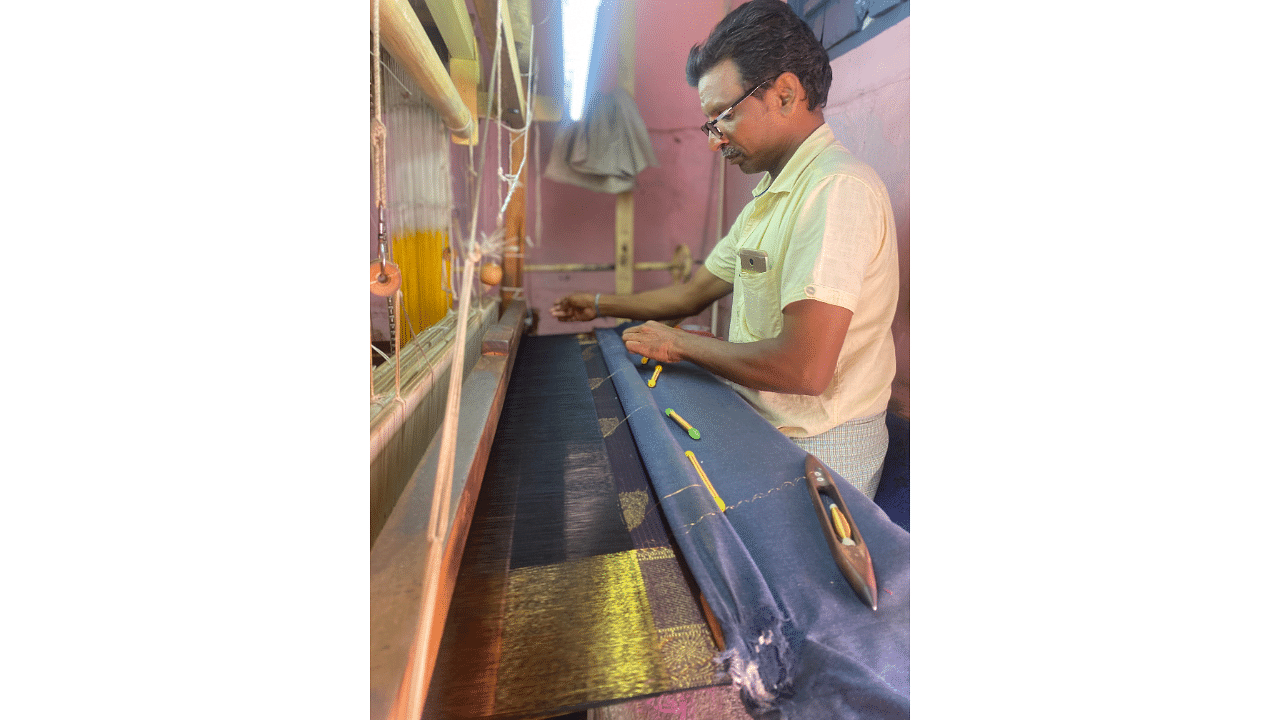
Yeri Swamy working on the 'shot effect' of Molakalmuru saris, where the body is woven with black warp and purple weft.
The wedding season is in full swing. Of the many Karnataka weaves that are popular among brides-to-be during this time, the Molakalmuru silk sari remains a top pick.
These saris are known for their 'shot effect'. That is, the colour of the fabric changes when seen from different angles or under different lighting conditions. Over time, these traditional saris have also adopted contemporary designs. It was conferred the Geographical Indication (GI) Tag in 2011 for its distinctive design features.
The sari is woven in Molakalmuru taluk in Chitradurga, that’s why the name. I learnt about the history of the weave on a visit to Molakalmuru early this month. Yeri Swamy is a weaver with 25 years of experience. He is part of the 10-member team at Sri Kanaka Silks and Saris, a popular workshop in the taluk. His family has been involved in sari weaving for three generations.
He said, "Back in the ’60s, the Swakulasali community from Maharashtra and the Padmasali community from Andhra Pradesh played a pivotal role in introducing silk weaving with gold in Molakalmuru." The weavers also enjoyed the patronage of the royal family of Mysore. He continued, “My father used to narrate stories about weaving saris for the idol at the Chamundeshwari Devi temple in Mysuru. Our family has carried on the tradition. I crafted a sky blue sari in nine yards for the goddess last year.”
Shot effect
Swamy was crafting a purple brocade sari for a wedding reception when I visited him. He explained the nuances of Molakalmuru saris. Traditional Molakalmuru saris are available in bottle green, black, blue, and turmeric yellow colours. “Kanchana, a shade of red with black or brown undertones, commonly seen in Kanjivaram saris, is also popular,” he said. Motifs like rudraksha (a circular figure divided into four parts with an X) and hamsa (swan) are common, and so are checkered patterns. The sari features a solid single colour on the pallu and the border.
To explain the shot effect, he pointed to the black yarn for warp and the purple yarn for weft. “Using two distinct colours for the body’s warp and weft creates the shot effect. This effect can be seen when the fabric folds and twists,” he said.
The signature style of Molakalmuru saris involves different colours on the body, the pallu and the border. But Swamy said the demand for single-coloured saris with brocade motifs featuring floral patterns is increasing. However, weavers like him continue to retain the ‘shot effect’ on the body while using a single-colour yarn for the pallu and border.
I also met weaver Lakshminarayana Baise. He was operating a single pit loom at his home and weaving a customised turmeric yellow wedding sari. It had a rani pink (hot pink) border and pallu with brocade work.
Baise draws inspiration from nature — fruits and birds. “The sari I’m currently weaving features a sitaphal motif on the pallu, complemented with small mango butta (a decorative, repetitive motif) and geometrical patterns. The body is plain but features a solid zari border,” he shared. It takes around eight days to complete the sari.
Keeping up with tradition
D H Srinivasa & Co, located in Molakalmuru, has been in the business since 1975. Tracing the evolution of designs, Srinivasa’s son D S Raghavendra said, “During my father’s era, the rudraksha design became commonplace. It was incorporated in two lines over a solid nine-inch border. The rudraksha butta adorned the sari’s body. Motifs like hamsa, peacocks, and checkered patterns (pooja checks and Maheshwari checks) also dominated these saris.”
Pooja checks showcase grid lines forming 2x2 inch squares that contrast with the body colour. Maheshwari checks are woven instead of lines dividing a grid into squares. The alternating black and white or yellow and orange checks are renowned.
Kanjivaram inspiration
The weavers are adapting the more popular Kanjivaram designs in Molakalmuru saris “for survival”, Raghavendra said. On the distinction between the Molakalmuru and Kanjivaram saris, Raghavendra said, “The weaving style is almost identical. The difference lies in the quality of gold zari and design motifs. Kanjivaram saris feature temple borders, kodi visri (floral pattern), elephants and peacocks while Molakalmuru is known for its rudraksha, peacock and hamsa motifs.” There’s also a growing demand for full-body floral butta saris, which are a departure from the traditional Molakalmuru saris.
Making the yarn
It is Baise’s wife Padmavathi who prepares the yarn for weaving the sari’s border and pallu. She explained, “Mulberry silk sourced from Ramanagara forms the base. It is initially rough to touch and off white in colour. Skilled workers dye the threads using chemical colours from Mumbai. After drying, these are cleaned at home and then I prepare the yarn. The zari used in the saris include 1-gram gold brought from Surat.”
A handwoven Molakalmuru sari typically lasts for 20 years but Baise claims their life can be extended up to 80 years. “We use four threads to create a single length thread. That makes it durable and stronger,” he detailed.
Wallet factor
A traditional Molakalmuru sari with Maheshwari checks and a nine-inch border costs around Rs 10,500 in Molakalmuru. A plain sari with a contrasting nine-inch border, featuring two rows of the rudraksha motif and an intricately crafted pallu, is available at Rs 6,500. Outside Molakalmuru, the same saris are priced 60-70% higher.
'Gandaberunda in demand'
Vanjre Ramesh, head of Molakalmuru Town Silk Weaver’s Co-operative Society, says saris with the Gandaberunda motif woven in the border are highly sought after. Gandaberunda is a mythical two-headed bird. It is considered the official state emblem of Karnataka and the royal insignia of Mysore kingdom. Molakalmuru saris with pooja checks and Maheshwari checks are also in demand. “We export these saris to the USA, Singapore, UAE and Australia,” adds Ramesh, a national-award winning master weaver.